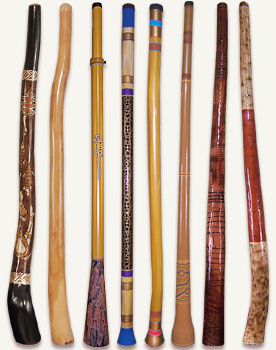
What is a Didgeridoo?
The
didgeridoo is believed to be the worlds oldest wind instrument, dating
back thousands of years. It originates as a musical instrument of the
North Australian Aborigine.
The didgeridoo is traditionally played accompanied with clap sticks
and/or the clapping together of boomerangs in Corroborees (ceremonial
dances). Players can also tap out rhythms on the side of the didgeridoo
using fingers or sticks.
A didgeridoo is traditionally made from one of many species of eucalyptus
branches or saplings. Species of eucalyptus number in the hundreds but
only about a dozen species are used for didgeridoo making. The eucalyptus is naturally hollowed out by termites whose nests abound in
the millions in Australia. It takes at least a year for the termites to
hollow a tree out. Harvesting has to be timed so that the wall thickness
of the instrument is not too thin or not too thick. It has to be "just
right". Making for the perfect instrument!
The
varying length of the wood that is sawed off and its thickness and
shape will determine which key the instrument will be in. Shorter
lengths yield higher pitches where as longer lengths yield lower
pitches. Didgeridoos generally range in keys from a high "G" to a low
"A". A common "C" didgeridoo will be two octaves below middle "C" of a
piano. The keys of C, D and E are the easiest keys to learn how to play on
the didgeridoo. To hear sound clips click here, to hear the different keys of a didgeridoo click here.
Bark
is usually stripped from the outside and the termites removed. A rim of
beeswax can then be applied to reduce the diameter of a large opening
down to more playable sized aperture. About an inch and a quarter,
similar to a tuba sized mouthpiece. Wax also creates a good airtight
seal for the mouth and makes it more comfortable to play. The instrument
can then be decorated with ochre paintings that symbolize a tribes food
and/or totems.
Didgeridoos can be made from a wide variety
of materials. Click here to see our modern didgeridoos.